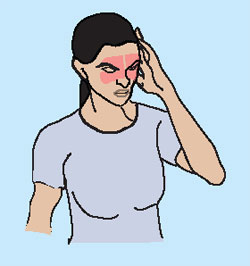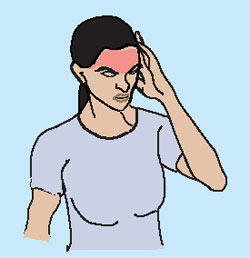
It’s a headache!You cannot go through life without having an occasional headache, but for some people the frequency of the attacks as well as the severity can affect their quality of life significantly. Although headaches are generally benign, they could also be a sign of a serious underlying health problem. A headache can be described as aching or pain in the head, located above the eyes, ears and back of the head. They may be associated with a range of other symptoms such as feeling sick, photophobia (when the light hurts your eyes) and noises. There are many causes for headaches and many treatments, but the main reason for an accurate diagnosis is to rule out a serious underlying medical condition. Headaches can be categorised into primary and secondary headaches. Primary headaches are those, which are not caused by any disease conditions. Examples are migraines, tension headaches, and cluster headaches. Secondary headaches, on the other hand, are those, which have a disease process, which causes them. Primary headaches These account for approximately 90% of headaches. Tension headaches These are the most common of primary headaches and usually present in middle-aged adults. There is a higher incidence in females compared to males. These can be caused by a number of physical conditions, such as arthritis in the neck and spine, joint problems, dilation of blood vessels, coughing, blockage in the sinuses (sinusitis) sneezing and fever. Mental conditions are also associated with these headaches, such as stress, depression and anxiety.
Migraines Migraines affect around 15% of adults. Again females are affected more than males and there appears to be a higher incidence if there are other family members suffering from them. There are two main kinds of migraines, those that cause an aura (classic migraine) and those that do not (common migraines).
An aura can be described as a symptom that is experienced prior to the onset of the migraine. Auras can be numbness of face or limbs, vomiting, blindness, paralysis of limbs, fainting etc. These symptoms normally resolve within an hour or so. Common migraines present with a sudden onset of headache. Recent studies have shown that the cause of migraines could be due to the change in activity (over activity) of the nerve cells in the brain called neurons, there is also evidence to suggest that a chemical messenger in the brain called serotonin is involved in precipitating them There are many trigger factors identified which seem to precipitate a migraine. Hormonal changes in women, loud noises, lack of sleep, bright lights, certain foods such as chocolate and cheese and smoking have all been identified as possible triggering culprits.
Cluster headaches These are rare primary headaches, they affect about 0.1% of the population. These are more common in males! The average age ranges from 28-35 years and such headaches normally begin at a young age. As the name suggests these headaches are a clustering of painful attacks, over many weeks or even months. The pain peaks at about 5 minutes and may last for about an hour. There are two types. Episodic, which is the common type, where you may have two to three headaches a day for about two months and not experience another headache for a year, after which the pattern will repeat, and chronic cluster headaches, where unfortunately you get no period of untreated sustained relief.
Secondary headaches
These are headaches that have an underlying medical cause. If a patient experiences a secondary headache, medical attention should be sought urgently. Some features, which can be symptomatic of secondary headaches, are higher body temperature, rashes, swelling of glands, tenderness in the neck and stiffness of joints. If you are elderly then underlying malignancies should be ruled out. If there is a history of brain haemorrhages in the family or the patient suffers from high blood pressure a bleed in the brain must be ruled out. As described in the MediScene article last month, a sudden onset headache could also be due to a ruptured blood vessel in the brain, causing a subarachnoid haemorrhage. Seek medical attention! Finally it is very important to stress a condition called medication-overuse headaches. People who have frequent headaches take regular painkillers, often in an attempt to prevent them coming on. The over-use of analgesia decreases their effectiveness with time, requiring the sufferer to take stronger medication. The reduced effectiveness of the medication can cause further headaches, known as rebound or withdrawal headaches, or medication overuse headaches. About 2% of patients suffer from overuse headaches and again women are affected more than males. So remember to use appropriate analgesia when suffering from a headache and if the frequencies of the headaches are changing such that you require to increase the dosage, seek medical advice. |
|
||||||
|| Front
Page | News | Editorial | Columns | Sports | Plus | Financial
Times | International | Mirror | TV
Times | Funday
Times | Medi Scene || |
| |
Reproduction of articles permitted when used without any alterations to contents and a link to the source page.
|
© Copyright
2008 | Wijeya
Newspapers Ltd.Colombo. Sri Lanka. All Rights Reserved. |

